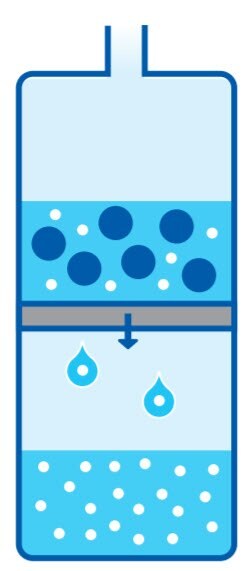Protein Concentration & Buffer Exchange

Protein concentration and buffer exchange are commonly used in protein and antibody purification, bioprocessing, and proteomic analysis workflows. Sample preparations of macromolecular solutions such as proteins, enzymes, antibodies, and viruses often yield large volumes of diluted proteins and other biomolecules in buffers that are incompatible with downstream processes or detection. Following sample extraction, dilute proteins often need to be concentrated and clarified prior to analysis or use.
Protein Concentration
Several methods exist for protein concentration, including filtration with porous membrane filters, dialysis in hyperosmotic solutions, and precipitation/salting out. Ultrafiltration provides a convenient method that utilizes semi-permeable membranes to concentrate proteins under pressure or centrifugal force with minimal denaturation, deactivation, and degradation of the proteins. Using this technique, excess fluid passes through the filter while target protein is retained, increasing the protein concentration by decreasing the sample volume.
Protein Enrichment
In protein enrichment, specific groups or types of proteins in a biological sample are concentrated for further analysis. Protein enrichment methods are used to isolate low-abundance proteins and reduce sample complexity. Enrichment separates and concentrates target proteins for improved downstream proteomic analysis. Ultrafiltration is often used in protein enrichment to separate classes of proteins based on molecular weight.
Buffer Exchange and Desalting
Purified proteins often need to be transferred to a suitable buffer for further analysis. Buffer exchange, desalting, and detergent removal can be accomplished using methods including:
- Dialysis: Small permeable molecules such as salts, detergents, solvents, and other impurities are removed based on their ability to pass through a membrane.
- Column chromatography: Salts are removed using gel filtration columns that rely on size exclusion for separation.
- Diafiltration: Salts, detergents, and other impurities are removed based on their molecular size using porous ultrafiltration membranes under pressure or centrifugal force.
Related Technical Articles
- Large-volume centrifugal filter devices are a convenient alternative to stirred cell ultrafiltration devices for purifying proteins from large volumes of solution.
- Large-volume centrifugal filter devices are a convenient alternative to stirred cell ultrafiltration devices for purifying proteins from large volumes of solution.
- Desalting at laboratory scale is a well-proven, simple, and fast method that will rapidly remove low molecular weight contaminants at the same time as transferring the sample into the desired buffer in a single step.
- The Amicon® Stirred Cell family of pressure-driven filtration devices provide an ideal solution for concentrating and buffer-exchanging large volumes of macrosolutes. These devices are available in multiple sizes to offer a wide range of processing volumes.
- For filtering large volumes of biological solutions, we manufacture specialized equipment including centrifugal filtering devices, discs, cells and solvents.
- See All (9)
Related Protocols
- Choose and prepare a biological buffer based on your pH requirements as well as the pKa, a measure of acid strength that accounts for pH, concentration, and temperature.
- This page shows how to perform sample desalting, buffer exchange and concentration for affinity chromatography of tagged proteins.
- Detergents are frequently used to solubilize proteins and nucleic acids during purification, but the presence of detergents may interfere with downstream analyses.
- If an antibody must be purified from a small sample volume (0.5-10 mL), then the Amicon® Pro Purification System is recommended.
- See All (17)
To continue reading please sign in or create an account.
Don't Have An Account?